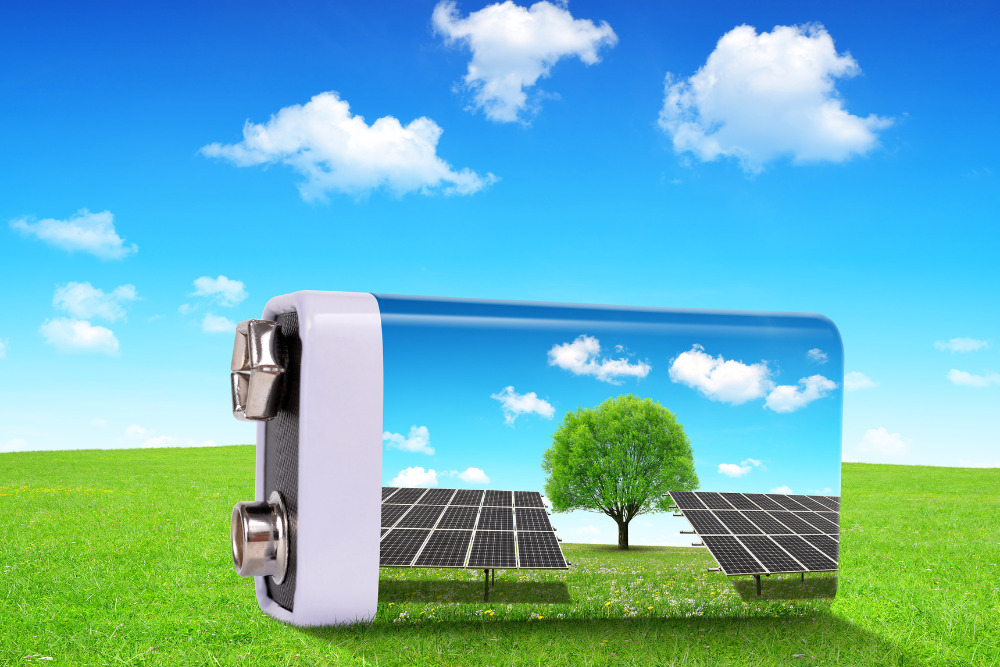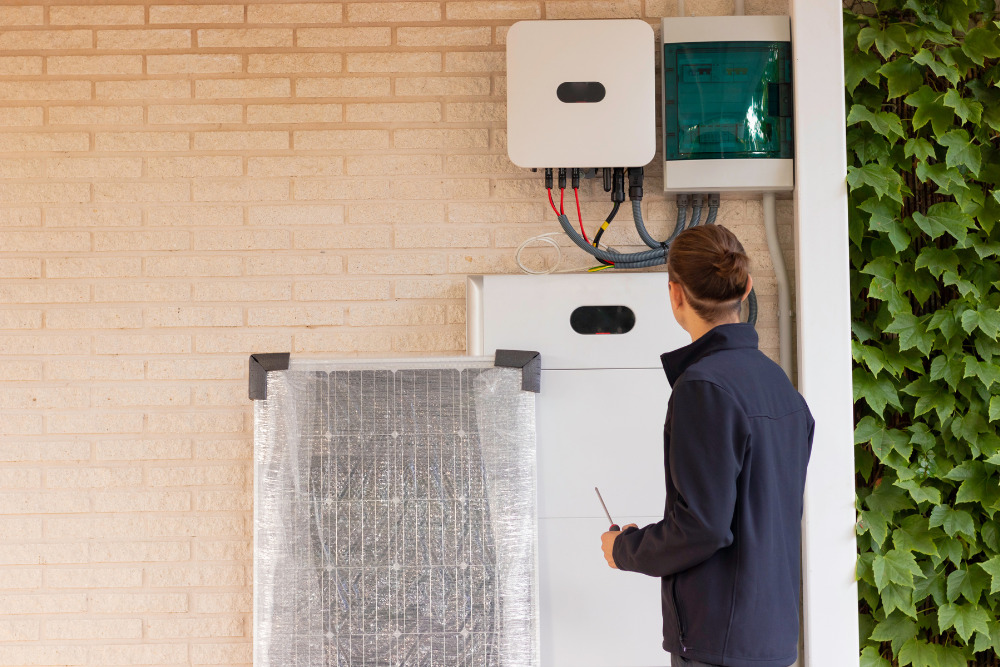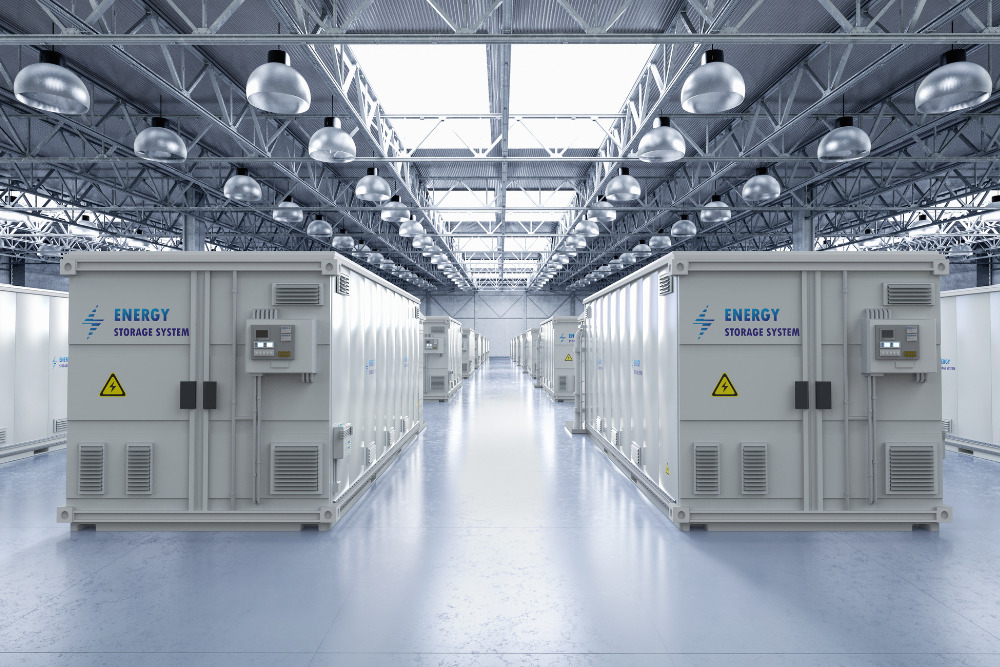
Solar energy storage systems (solar batteries) capture excess energy during the sunniest times of the day. This power is then stored in the battery and ready for use at night when the solar panels aren’t producing energy. Batteries also provide backup power for grid-tied solar systems during power outages.
Although solar panels provide clean energy and help reduce energy costs, they have two shortcomings: they only generate power when the sun is shining, and they can’t store excess energy on their own.
Solar energy storage technologies solve this problem and enhance the efficiency of solar systems. Solar batteries capture solar panel-generated electricity, store it, and release it when needed.
How Does Solar Energy Storage Work?
Solar energy storage involves gathering excess energy from a solar panel system and storing it in another form for later use.
Solar panels generate maximum energy during peak sunlight hours. With a solar energy storage system, you don’t have to use all the electricity your solar array produces. The storage devices save surplus solar energy in chemical, thermal, or kinetic form and then release it when there’s peak demand.
Therefore, a solar-plus-storage system is more efficient as it balances power supply with demand.
Do You Need A Solar Energy Storage System?
You only NEED an energy storage system for an off-grid solar system. For all other applications, it’s a nice-to-have that will boost your system’s performance and give you greater energy independence.
Most homeowners and businesses that install solar energy systems have their solar panels tied to the electric grid. This allows them to still draw electricity when their solar panels aren’t working (i.e. night time or periods of little sun). Being grid-tied also enables you to send excess generated power back to the utility company to earn credits and lower your electric bill (net metering billing).
But grid-tied systems present some challenges for solar system owners:
- Solar systems won’t work during power outages (unless paired with a solar battery), and
- They only generate electricity when the sun is shining.
Those are the two primary reasons most people invest in a solar battery system.
Other reasons to consider a solar energy storage system include:
- If you want to go completely off-grid: You don’t have to be tied to your local utility when you can store excess power from your solar panels. An off-grid system uses solar from the sun during the day and draws from the battery at night or when the sun isn't shining.
- You’ll enjoy power resiliency: Since solar energy production depends on weather elements, temperatures, and obstructions, you can’t enjoy a consistent power supply. But with energy storage, you have backup power during outages or unfavorable weather conditions.
- Power storage saves you money: A grid-tied system exposes you to rising electricity costs, depending on energy demand and supply. You can save money on electric bills by being self-sufficient.
- You’ll reduce your carbon footprint: A solar energy storage system provides a continuous clean energy supply and minimizes reliance on fossil fuels.

Types Of Solar Energy Storage Solutions
Solar energy storage solutions fall into different categories depending on what form of energy they store.
Batteries Energy Storage Systems (BESS)
Batteries energy storage systems (BESS) are the most practical solar energy storage solutions for homeowners. They’re rechargeable solar batteries that capture solar energy and store it in chemical form.
So when your solar panels absorb sunlight, the batteries convert the DC (direct current) energy to AC (alternating current) and bank it for later use.
Here are the main types of solar batteries:
- Lead-acid batteries are the most common battery types since they’re cheap. But they’re bulkier and have a lower depth of discharge (DoD) and shorter lifespan.
- Lithium-ion batteries are lighter and more compact than lead-acid batteries. Their DoD is also higher, making them more pricey. But they’re increasingly becoming popular due to their efficiency and longer shelf life.
- Nickel-cadmium batteries are small, compact, and durable. They can also work over a wide temperature range, making them practical in extreme climates. Their only downside is cadmium’s toxicity, making disposal unsafe.
- Flow batteries are a new battery technology with an expandable capacity. They contain water-based electrolytes that flow in two tanks (battery chambers).

Pumped Hydro Energy Storage (PHES)
Pumped hydro energy storage (PHES) involves two-reservoir systems installed along power grid transmission lines. PHES systems comprise the largest percentage (about 93%) of utility-scale energy storage in the US. They store and release renewable energy by pumping water in and out of the reservoirs, depending on the energy supply and demand.
When there’s excess solar energy, the PHES system uses it to power turbines that pump water into the higher reservoir. Then, when supply drops and demand increases, the system releases water back into the lower reservoir, generating kinetic energy.
PHES is an inexpensive and efficient way of storing solar energy. But setting it up requires ample space, regulatory permits, and a complex process. It’s generally only used in commercial applications, but may be suitable for large off-grid systems that power a homeowner’s farm.
Thermal Storage Systems (TSS)
Thermal storage systems (TSS) store surplus solar power in insulated tanks using fluid like molten salt or solid matter. TSS systems are practical storage solutions for companies because:
- They have a large storage capacity.
- They can also turn saved thermal energy into superheated steam to run turbines, producing electricity.
- They’re reliable and long-lasting - the molten salt can be cooled and heated for 30 years.
However, installing TSS systems can be expensive since the systems require plenty of space.
Flywheel Energy Storage (FES)
Flywheels have large rotor blades that spin in a vacuum, producing a force that powers turbines. This storage system stores excess power in the form of kinetic energy and turns it back to electricity upon demand.
FES systems are more efficient and have faster response rates than solar battery storage systems. But their installation requires higher upfront costs and a bigger space.
Compressed Air Energy Storage (CAES)
These systems use excess energy to compress and store air in underground tanks (caverns). CAES systems release the compressed air upon demand, using it to power turbines and produce electricity.
They have higher efficiency and reduce carbon emissions by minimizing the use of natural gas. CAES systems are also durable and have a high storage capacity. On the downside, they require specific underground locations to set up, so they are rare.
How Much Do Solar Energy Storage Systems Cost?
The cost of solar energy storage systems is highly dependent on several factors.
The installation cost of a solar energy storage system is calculated in dollars per kilowatt-hour ($/kWh).
The following factors determine how much you’ll spend in setting up a solar energy storage system:
- Type of solar energy storage system: The installation costs will depend on the type of solar energy storage system. For instance, a PHES system costs around $106 to $200/kWh compared to $400 to $1,000 for a BESS system. Also, the price of battery storage systems varies depending on the type of battery, its chemistry, capacity, and efficiency.
- The capacity of solar energy storage system: It’s relatively cheap to install energy storage systems with a smaller energy capacity. For example, a 10kWh solar battery costs $4,000 to $10,000, while a 25kWh battery could be around $10,000 to $25,000.
- The size of the solar-plus-storage system: Your energy needs determine the size of the system to install, which affects the upfront and maintenance costs. Hence, residential solar-plus-storage systems are generally cheaper than commercial systems since they’re smaller. However, large-scale commercial projects can benefit from economies of scale and have lower costs per kilowatt-hour of capacity.
- Time of installation: You’ll save money if you pair a solar energy storage system with your initial solar installation than if you set it up later.
- Location: Where to install a solar energy storage system determines how much it will cost. For instance, systems installed in remote or off-grid areas are expensive.


